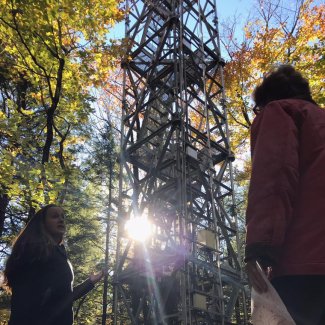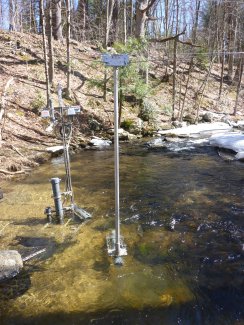An Adaptive Observatory: Here for the Long Haul
February 7, 2024
Maintaining a 30-year, continental-scale observatory takes a lot of planning. How do you ensure data consistency and continuity across such large scales of space and time, staying functional and effective even through ecosystem change?
The National Ecological Observatory Network was designed from the outset to be resilient and adaptive to change, key attributes necessary to support data collection across decades and landscapes—no matter the challenges encountered.
Observing Changes in Ecosystems Over Time
NEON is one of the most ambitious long-term ecology programs ever conceived. Funded by the National Science Foundation (NSF) and managed and operated by Battelle, NEON collects standardized ecological data from 47 terrestrial and 34 freshwater aquatic field sites across the continental U.S., Alaska, Hawaii, and Puerto Rico. The Observatory transitioned from the construction phase to full operations in 2019 and is designed to run through 2049 or longer. Battelle was recently awarded the operations and management) of the Observatory through at least 2028.
Why the 30-year timespan? Because it takes that long to observe most trends in ecology. Ecological data can be pretty noisy on shorter timescales, with large variations day-to-day or year-to-year due to natural fluctuations in weather, unusual events such as wildfires or hurricanes, and human activity. It is only when we look at the decade scale or longer that real trends become clear.
The NEON program gives researchers consistent, high-quality, and comparable data across both spatial and temporal scales. This allows for improved understanding of ecosystem-level changes, from regional to continental scales and from short-term events to long-term trends. All data is open and freely available through the NEON Data Portal.

The flux tower at BART
This unique program fills a critical need in the ecology community, although it is not the first nor the only ecological network collecting long-term data. The Long-Term Ecological Research (LTER) Network, for example, has been collecting data at some of its sites for over 40 years. LTER, however, is a research-driven network and data collection at its sites is largely driven by individual Principal Investigator priorities and site-specific themes. That means the same data products are not available at all LTER sites to address continental-scale questions as can be addressed by NEON data. Thus the NEON and LTER networks are highly complementary.
To answer pressing, big-picture questions in ecology around biodiversity, habitat change, invasive species, and ecosystem dynamics, researchers need data collected consistently across long time scales. To fulfill that mission, the Observatory was designed from the ground up for resilience and adaptability.
Observatory Design: Adapting to Change
Resilence is the ability to anticipate, prepare for, and respond to hazardous events, trends, or disturbances. In the context of the Observatory, that means proactively designing instrument systems and infrastructure to withstand the harshest conditions anticipated at each field site. It also requires the ability to monitor and evaluate the health of Observatory components, respond quickly if a problem is detected, and adapt the design as needed for changing conditions.
For example, NEON tower infrastructure in Puerto Rico is designed to withstand hurricane-force winds. There is also a hurricane protocol in place so NEON field staff know to bring in delicate instruments before severe weather hits. Resilient design and established protocols at NEON field sites keep people and infrastructure safe and minimize data disruptions during and after extreme events. It also enables the NEON program to provide critical data about ecosystem response to natural disasters, including hurricanes, wildfires, or flooding.

An overhead cable system that suspends the sensor in the stream from above instead of mounting it to a fixed support.
Adaptability is also key. Equipment and protocols have been adapted over time as we learn more about the challenges faced at each unique site. In 2022, aquatic sensor infrastructure was upgraded at some NEON stream sites; sensors were mounted on overhead cables to improve uptime and enable better data collection at "flashy" stream sites prone to rapid increases in flow. NEON also added a new drone foliar sampling protocol to improve safety and enable better access to canopy samples in tall forests or remote areas.
All changes to the observational or instrument systems are thoroughly tested to ensure data quality and comparability before and after the change. Improving uptime and infrastructure hardiness cannot come at the expense of data quality and validity. At the same time, the Engineering Team must consider the unique vulnerabilities of the ecosystems in which we operate. This may require adaptations to sampling protocols or infrastructure, such as building low-impact walkways to limit contact with delicate permafrost at Taiga field sites in Alaska.
To help ensure that instrument systems collect continuous data, NEON engineers built an alert system and dashboard that provides near real-time visibility into instrument health and operation. The system queries all the data streams produced across the NEON Instrument System each day. Alerts notify operators if there is an anomaly in instrument behavior or data availability, allowing the instrument team to respond to and resolve problems quickly, maximizing uptime and data quality.

Utqiaġvik field site in the Alaskan tundra. Photo credit: Jim Hojohn.
Regular maintenance and calibration are necessary as well. Instrument systems are maintained in the field regularly and recalibrated periodically by the Calibration and Validation Laboratory. This critical work is how NEON ensures data consistency, quality, and comparability over time at all our field sites.
Data for a Changing World
NEON data is helping to illuminate how ecosystems are changing in response to changes in land use, the impact of invasive species, and ecosystem change. These insights could be useful for planning emergency response measures, developing sustainable land management plans, predicting the spread of pathogenic diseases, and ensuring food security.
Beyond the data collected, NEON's reliable infrastructure is also available for use. Through the Assignable Assets program, NEON has become a test bed for instrumentation and technology that support resilience. NEON sites span the continent, enabling testing in all major U.S. ecoclimatic zones and a range of ecosystem types – ideal for testing technology like the Arable sensor equipment for "decision agriculture."

Arable Mark 2 sensor installed on the GUAN tower in Puerto Rico
NEON can also support customized observational sampling for climate-focused projects. One project with the Department of Defense (DoD) was formed to collect permafrost core samples at field sites located near military bases in Alaska as part of their "Cold Environment Risk Assessment." Samples will be sequenced for potential pathogenic bacteria and viruses to understand potential health risks related to warming permafrost.
Over the next 25 years, the NEON team will continue to adapt protocols and infrastructure to changing conditions. The Observatory is committed to ensuring the continued availability and quality of data for researchers to investigate the drivers of ecosystem change and to build better models for the future. That will help communities, businesses, and other stakeholders understand their risks and make their own resilience and adaptation plans. By designing and adapting this ecological observatory for the long haul, NEON supports resilience for our communities, the U.S., and the world.

